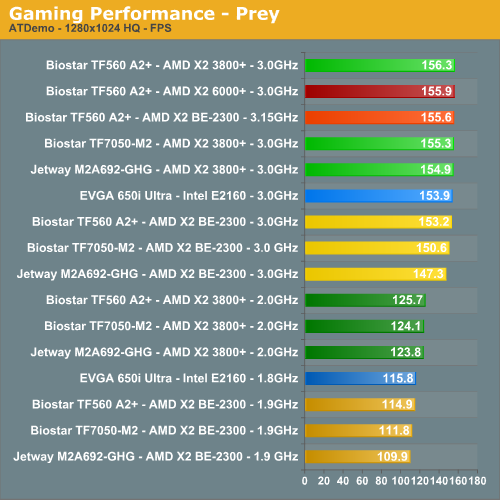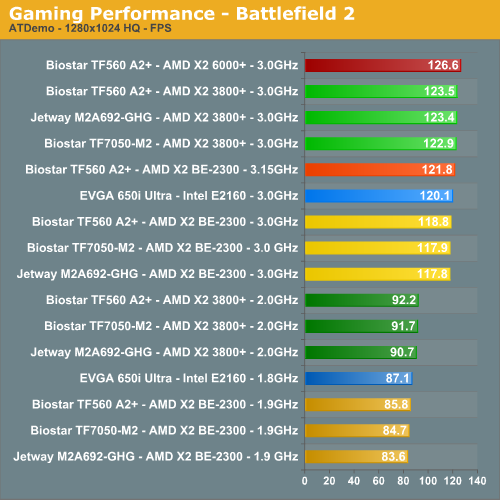Biostar TF560 A2+: Overclocking NVIDIA's new nForce 560
by Gary Key on August 2, 2007 12:15 AM EST- Posted in
- Motherboards
Gaming Performance
Our limited look at gaming performance consists of Prey and Battlefield 2. These two particular titles are both CPU throughput and memory latency sensitive when utilizing a GPU such as our MSI 8800GTX. We ran benchmarks with our standard 1280x1024 resolution set to High Quality mode. Given the number of users that run 19" LCDs these days, 1280x1024 represents one of the most commonly used resolutions and will still keep these two particular titles from becoming GPU bound.
Prey
Prey offers some superb action sequences, unique weapons and characters, and is a visually stunning game at times. It still requires a very good GPU to run it with all of the eye candy turned on. We set all graphic settings to their maximum except for AA/AF and utilize a custom timedemo that takes place during one of the more action oriented sequences.

Battlefield 2
This benchmark is performed using DICE's built-in demo playback functionality with additional capture capabilities designed in house. When using the built-in demo playback features of BF2, frames rendered during the loading screen are counted in the benchmark. In order to get a real idea of performance, we use the instantaneous frame time and frames per second data generated from our benchmark run. We discard the data collected during the loading screen and calculate a result that represents actual game play.

Gaming Summary
In a switch from our application benchmarks, we see our AM2 processors performing very well against the Intel E2160 in the gaming benchmarks from both a stock and overclocked performance perspective. It appears that for this particular task, the lack of L2 cache finally catches up with the Core 2 E2160. In Prey, the BE-2300 has a performance increase of 39% while the X2 3800+ improves by 26% when overclocked, and the E2160 improves by 33%. Battlefield 2 experiences similar gains with the BE-2300 being 42% faster and the X2 3800+ being 36% faster, and the E2160 is also 38% faster. The L2 cache advantage of the X2 6000+ allows it to maintain a lead in BF2 and almost overcome the HTT and memory throughput advantage of the overclocked X2 3800+ in Prey. Gaming performance is still driven by the GPU, especially in the latest titles, but every extra bit of CPU performance always helps.
Looking at the AM2 boards, the nF560 appears to be the fastest gaming solution of these three, at least in the two tested games. The margins aren't huge, but you do get up to a 3% performance increase in certain instances. As we become more GPU bound with increasing CPU speeds, the differences between the platforms and chipsets diminishes.
Our limited look at gaming performance consists of Prey and Battlefield 2. These two particular titles are both CPU throughput and memory latency sensitive when utilizing a GPU such as our MSI 8800GTX. We ran benchmarks with our standard 1280x1024 resolution set to High Quality mode. Given the number of users that run 19" LCDs these days, 1280x1024 represents one of the most commonly used resolutions and will still keep these two particular titles from becoming GPU bound.
Prey
Prey offers some superb action sequences, unique weapons and characters, and is a visually stunning game at times. It still requires a very good GPU to run it with all of the eye candy turned on. We set all graphic settings to their maximum except for AA/AF and utilize a custom timedemo that takes place during one of the more action oriented sequences.

Battlefield 2
This benchmark is performed using DICE's built-in demo playback functionality with additional capture capabilities designed in house. When using the built-in demo playback features of BF2, frames rendered during the loading screen are counted in the benchmark. In order to get a real idea of performance, we use the instantaneous frame time and frames per second data generated from our benchmark run. We discard the data collected during the loading screen and calculate a result that represents actual game play.

Gaming Summary
In a switch from our application benchmarks, we see our AM2 processors performing very well against the Intel E2160 in the gaming benchmarks from both a stock and overclocked performance perspective. It appears that for this particular task, the lack of L2 cache finally catches up with the Core 2 E2160. In Prey, the BE-2300 has a performance increase of 39% while the X2 3800+ improves by 26% when overclocked, and the E2160 improves by 33%. Battlefield 2 experiences similar gains with the BE-2300 being 42% faster and the X2 3800+ being 36% faster, and the E2160 is also 38% faster. The L2 cache advantage of the X2 6000+ allows it to maintain a lead in BF2 and almost overcome the HTT and memory throughput advantage of the overclocked X2 3800+ in Prey. Gaming performance is still driven by the GPU, especially in the latest titles, but every extra bit of CPU performance always helps.
Looking at the AM2 boards, the nF560 appears to be the fastest gaming solution of these three, at least in the two tested games. The margins aren't huge, but you do get up to a 3% performance increase in certain instances. As we become more GPU bound with increasing CPU speeds, the differences between the platforms and chipsets diminishes.










21 Comments
View All Comments
DrMrLordX - Thursday, August 2, 2007 - link
AM2+ K10 chips will "plop right in"to AM2 boards with the proper BIOS support, so I would assume they would work in this board too, regardless of whether it supports HT3, separates power planes, etc. Of course, that's all up to the board manufacturer and their BIOS support for K10.